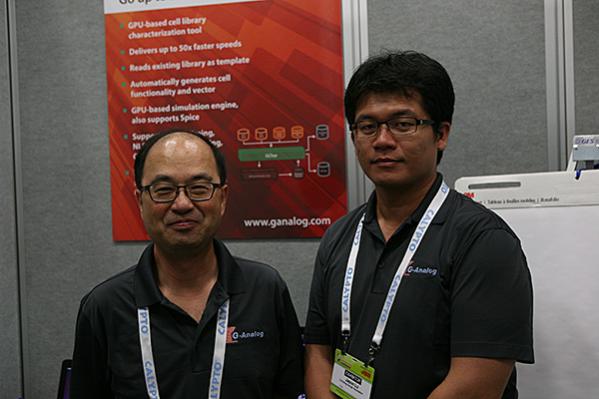Jeff Tuanis the CEO and President of an EDA startup called G-Analog, founded in May 2012. His background includes working at: Cadence, Epic, Synopsys, Nassda, Chartered Semi and GLOBALFOUNDRIES. Jason Lu is the R&D manager. We met at DAC last week to talk about his company’s new product called Gchar for IC library characterization using a GPU-based SPICE circuit simulator.

Jeff Tuan, Jason Lu
Discussion Notes
More need for circuit simulation runs: Monte Carlo, OCV, many corners.
Mission: Apply GPU to SPICE simulation. Up to 50X speed up for cell characterization (compared to HSPICE). HSPICE compatible netlist input, BSIM3 and BSIM4 models.
Generates OCV tables.
Gchar – GPU-based cell characterization, for library timing, power, noise characterization, OCV table generation.
– Production release in Q2, 2013.
– GChar : all the simulation data stays on the GPU, not the CPU, for maximum efficiency. Simultaneously simulate 10,000 of simulations.
– NVidia card, from 1 t 4 cards.
COncurrent simulation – many circuits at the same time (SIngle Instruction, Multiple Data – SIMD). An inverter or nand gate are examples of concurrent topologies
GChar looks at your GPU and CPU, then sends your netlist to each one.
Results – comparisons versus Open Source NGSPICE, and Gsim is within .41%. Gsim is not sold as a general purpose SPICE simulator.
Gsim – TRAN, DC.
Plot – Voltage, current.
FinFET simulation – BSIM CMG model in Verilog A? Convert into a C model, then support that soon.
Use both multiprocess and multithreading. recommended configurations.
GTS680 has 2G RAM and 1536 cores
GTX Titan has 6GB of RAM and 2688 cores
Gchar is an accelerated cell library characterization tool, user friendly, reads netlist and cell library, uses both Gsim and SPICE, creates: NLDM timing, NLDM power, CCS timing, CCS Noise models.
Sales rep in Taiwan, Kaviaz. Expect first sales in Taiwan. Private funding. Too earl y to be sold.
Press release and first customer to come, stay tuned.
OS – Linux Red Hat.
Benchmarks – Gchar 21,717 seconds (6.03 hr) versus 3 days (other tool).
1250 cells (# of SPICE simulators?)
– 1890 cells, Gchar 1.59 days vsu 5 days. Could be faster if more Titan boards were used. (# of SPICE simulators?)
Gchar – batch oriented tool, not a GUI or interactive tool. Can be restarted.
On Chip Variation (OCV) simulation
OCV approaches : Fixed OCV, AOCV (stage based), POCV (used by Extreme DA, now Synopsys), POCV (single stage).
Gchar – uses both sensitivity analysis an MC to obtain statistical informaiton.
– Accurate mode, fast mode.
OCV Benchmark
– with 47 cells, simulated in Fast mode: 20.13 minutes with a single GTX680 GPU. With Titan it is 8X faster. 23,000 Monte Carlo simulations. From Monte Carlo can calculate the OCV values.
Summary
The last GPU-based company to offer a SPICE tool was Nassda and they have gone away, so let’s see what G-Analog can do in the IC library characterization marketplace.
lang: en_US
Share this post via:









Quantum Advantage is About the Algorithm, not the Computer